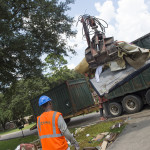COLUMBIA, S.C. (Tuesday, Oct. 25) – Homeowners and renters in three more South Carolina counties – Berkeley, Charleston and Chesterfield – are now eligible to receive Individual Assistance from the Federal Emergency Management Agency to help them recover from flooding caused by Hurricane Matthew.
There are now 24 South Carolina counties eligible for federal disaster assistance. Of those counties, 23 also are eligible for 75 percent cost reimbursement for debris removal and emergency protective measures resulting from the hurricane. Additional reimbursement is available to 18 of those counties for repair or replacement of public works facilities damaged or destroyed by the hurricane and flooding, also at 75 percent of cost.
The county itself, its cities and towns and certain nonprofits that perform quasi-government functions are eligible to apply for public assistance grants.
All Public Assistance reimbursements are a benefit to taxpayers in those counties to the extent that they do not have to pay for the needed repairs and replacements through higher tax assessments.
Individual Assistance is available to homeowners and renters in these 24 counties: Allendale, Bamberg, Barnwell, Beaufort, Berkeley, Calhoun, Charleston, Chesterfield, Clarendon, Colleton, Darlington, Dillon, Dorchester, Florence, Georgetown, Hampton, Horry, Jasper, Lee, Marion, Marlboro, Orangeburg, Sumter and Williamsburg.
The first step for individuals and households to receive assistance is to register with FEMA. There are no costs involved to receive FEMA assistance.
Disaster survivors may register in any of the following ways:
- Online at DisasterAssistance.gov;
- On the FEMA Mobile App;
- Calling 800-621-3362 (FEMA);
- Applicants who use 711 or Video Relay Service may also call 800-621-3362;
- People who are deaf, hard of hearing or have a speech disability and use a TTY may call 800- 462-7585;
- The toll-free numbers are open from 7 a.m. to 11 p.m., seven days a week; Multilingual operators are available.
Assistance for eligible survivors can include grants for temporary housing and home repairs, and for other serious disaster-related needs, such as medical and dental expenses or funeral and burial costs. Also, low-interest disaster loans from the U. S. Small Business Administration are available for businesses of all sizes (including landlords), private nonprofits, homeowners and renters.
The grants are intended to enable repair of a dwelling to the extent necessary to be safe, sanitary and secure for the number of occupants who live there. It is not a substitute for insurance coverage.
Households that have flood insurance are not eligible for an Individual Assistance grant unless their flood insurance is not enough to match FEMA’s minimum repair standard.
Renters and homeowners with flood insurance should register with FEMA in case their insurance coverage does not provide the necessary level of repair. The registration period ends 60 days after the initial disaster declaration, but those who register remain eligible to receive benefits after registration closes.
In South Carolina, the “One SC Fund” supports and directs funds to nonprofit organizations providing disaster relief & recovery assistance. http://yourfoundation.org/community-impact/one-sc-fund-sc-flood- relief/. Survivors in the state who need food, clothing, and shelter to call 2-1-1, and for storm clean up to call 800-451-1954.
For more information, visit the South Carolina Emergency Management Division at http://scemd.org/.
All FEMA disaster assistance will be provided without discrimination on the grounds of race, color, sex (including sexual harassment), religion, national origin, age, disability, limited English proficiency, economic status, or retaliation. If you believe your civil rights are being violated, call 800-621-3362 or 800-462-7585(TTY/TDD).
You can receive weather alerts, safety tips and learn about disaster resources by downloading the free FEMA App, available for Apple, Android, and Blackberry mobile devices. Visit fema.gov/mobile-app for more information.
FEMA’s mission is to support our citizens and first responders to ensure that as a nation we work together to build, sustain, and improve our capability to prepare for, protect against, respond to, recover from, and mitigate all hazards. Follow us on Twitter at https://twitter.com/femaregion4 and the FEMA Blog at http://blog.fema.gov.
The SBA is the federal government’s primary source of money for the long-term rebuilding of disaster- damaged private property. SBA helps businesses of all sizes, private non-profit organizations, homeowners and renters fund repairs or rebuilding efforts and cover the cost of replacing lost or disaster-damaged personal property.
These disaster loans cover losses not fully compensated by insurance or other recoveries and do not duplicate benefits of other agencies or organizations. For more information, applicants may contact SBA’s Disaster Assistance Customer Service Center by calling 800-659-2955, emailing disastercustomerservice@sba.gov, or visiting SBA’s website at www.sba.gov/disaster. Deaf and hard-of-hearing individuals may call 800-877-8339.




